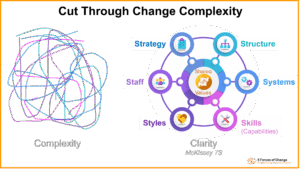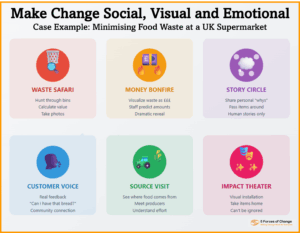What Drives Results?
Organisational change is about getting better results; enhancing quality, increasing throughput, boosting employee engagement, transforming customer service, and a host of other things. But, where do you start?

Fig. 1: What Drive’s What?

You could begin with the Results themselves – at the right-hand end of Figure 1: ‘What Drives What?’, which illustrates the interdependent sequence of human drivers that lead to Results. For instance, you could publish scores, such as daily throughput volumes or customer feedback ratings, so everyone involved is clear about current performance level. You can also set targets to give people something to aim for; encouraging people work harder or to treat customers better. However, if the causes of poor results are deep-rooted, then the impact will be limited or even futile, like a football manager standing on the touchline imploring his players to score more goals.
Next come Behaviours. This is the most popular starting point for leaders in the workplace, judging by the level of investment made in a myriad of tools designed to address behaviours directly; incentives schemes, training courses, performance management, leadership directives, written procedures, visual management, 30-day challenges, penalties for incorrect behaviour etc. These can have a big impact on knowledge, skills and motivation, and play a key role in delivering results. But they rarely, if ever, generate transformational change.
Leveraging Mindset Change

Fig. 2 Leveraging Mindset Change
As we venture leftwards along ‘What Drive What?’ sequence, we enter territory less explored by managers. And the further you head in this direction, the more leaders may feel ill-equipped to make a difference; changing mindsets is seen as the province of specialists and psychologists. Another popular view is that Mindsets are fixed and cannot be changed, and, even if they could be changed, such work falls outside the remit of a manager. Yet the realm of Mindset change is where the greatest opportunities exist for significant and lasting improvement to Results. A small shift in Beliefs – ‘A’ in Fig. 2 – leads to a major and lasting shift in Results – ‘B’. The further left you venture the greater the leverage you have.
Culture Change
It is not every day that organisations need to move the mindsets of their people, but when they do, it is often referred to as a ‘culture change’. Examples include, a construction company instilling safety-conscious culture, following a poor history of injury and death at work, a failing school creating an ethos of high-achievement, or a hotel chain shifting its focus from cost to customer service. Usually, the current culture has built up over a considerable period of time and become embedded in the DNA of the organisation. So, any attempt to shift Behaviours using tool like training or performance management, designed to address behaviours rather than their underlying causes, is doomed to failure. For example, getting people to inwardly digest and sign up to a set of safety procedures will not shift the dial in a construction company that has be flouting the regulations for years and prioritizing output and profit above all else.
The good news is that Attitudes (settled ways of thinking or feeling about specific things) and Beliefs (things that people accept as true; firmly held opinions) and Values (principles or standards of behaviour; judgements of what is important in life) can be shifted. The bad news is that this takes a lot of time and energy, and won’t happen unless the effort is championed and embodied by leaders. Another piece of good news it when Attitudes, Beliefs and Values change, they stick. The further you venture to the left on the ‘What Drives What?’ sequence, the greater and more long-lasting the rewards.
Learn More
For more on shifting Mindsets see the ‘The Leading Successful Change‘ eLearning course or the two books: ‘The 5 Forces of Change – a blueprint for leading successful change’ and ‘5 Tales of Change – how people have wrestled with change and one’, available in paperback and Kindle editions.








